Music isn't just for listening anymore.
It's becoming something you can step inside. From live concerts in virtual worlds to album art that comes alive on your phone, AR and VR are turning the music industry into an immersive playground.
This is where the question comes:" What is the role of AR & VR in music apps, and how are they changing the game?”
What once felt like science fiction is now transforming how fans experience, create, and interact with music.
Investors are eyeing this shift. Startups are building around it. And artists? They're using tech to connect with global audiences like never before.
This blog dives deep into how AR & VR in music apps are shaping the future of sound, stage, and storytelling.
Understanding AR & VR in Music Apps
AR & VR in the music industry isn't just a trend– it's a total game-changer.
These immersive technologies are transforming music apps into full-blown experiences that fans can feel, not just hear.
If you're wondering what is AR in music apps, think of it as the tech that lets digital visuals, like animations or lyrics, interact with your real-world environment through your phone or glasses.
On the other hand, how does VR enhance music experiences? By placing you inside a 360° soundstage where you're not just listening but living the music.
For startups looking to create a music app, these features offer powerful ways to engage users. And in a growing trend in music app innovation, immersive content isn’t just a cool add-on– it's becoming the new standard.
Here is a breakdown of the Augmented Reality & Virtual Reality in music apps:
|
Feature |
AR in Music Apps |
VR in Music Apps |
|
User Experience |
Overlays digital elements (lyrics, visuals) on real-world environments |
Fully immersive 3D concerts and virtual music worlds |
|
Popular Apps |
Spotify’s AR filters, Harry’s House AR album |
MelodyVR, Wave, Meta Horizon Venues |
|
Artist Benefits |
Interactive merch, AR music videos |
Global virtual tours, no physical venue limits |
|
Fan Engagement |
Scan-to-play AR experiences, social sharing |
Front-row concert access from home |
|
Future Potential |
AR glasses integration, live AR collaborations |
Holographic performances, AI-driven VR avatars |
With this out of the way, let’s find out how AR & VR are becoming essential for music apps.
Real World Examples of AR & VR in Music
From neon-soaked VR soundscapes to phone-powered AR jam sessions, these six trailblazers prove immersive tech isn’t just hype– it’s reshaping how we create, share, and experience music.
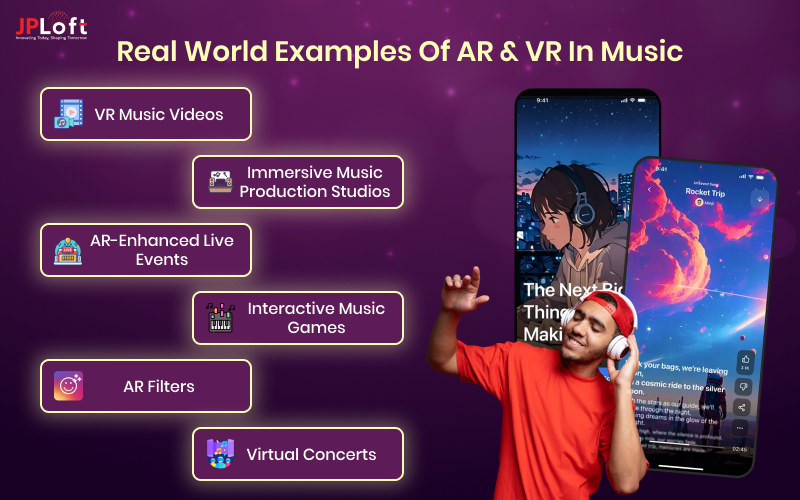
Dive in to see how artists, developers, and fans are already living inside the beat.
1. VR Music Videos
A music video you can step inside, explore, and interact with. Instead of passively watching, you become an active participant-- navigating environments that respond to your gaze and actions. These experiences blend storytelling, gameplay, and sound design into one cohesive adventure.
Example: The Weeknd’s “Blinding Lights” VR drops you into a neon city. Chase floating notes with your Quest headset-- each one unlocks a secret remix.
2. Immersive Music Production Studios
A virtual workspace where you manipulate sounds in 3D. Imagine building tracks by physically grabbing beats, arranging samples around you, and hearing changes in real time as you move. Collaboration happens face-to-face in virtual rooms, making geography irrelevant.
Example: In SoundscapeXR, you grab mid-air synths, twist glowing knobs, and mix tracks alongside collaborators in Paris or L.A.-- all in zero-gravity.
3. AR-Enhanced Live Events
Real concerts augmented with digital effects on your phone. These overlays can include visuals, interactive cues, and contextual information-- turning any vantage point into a personalized front-row seat. Fans engage more deeply as they control their view of the show.
Example: At Primavera Sound 2023, fans pointed their phones at the stage to see 3D butterflies and lyric animations fluttering above the band.
4. Interactive Music Games
Games that turn your movements into musical performance. They combine rhythm mechanics with motion tracking, so your physical actions directly influence the soundtrack. This gamification of music fosters both skill development and entertainment.
Example: Sound Beats VR has you swing virtual drumsticks at glowing pads in time with indie tracks, then compete on live leaderboards.
5. AR Filters
Smartphone effects that layer musical visuals over real life. These filters can react to your audio input or gestures, creating dynamic, shareable performances. They blur the line between creator and audience by letting anyone add digital flair to their music.
Example: Apple Music’s AR Jam filter surrounds your guitar with virtual amps and disco lights-- tap air strings to drop bass and record your mini-concert.
6. Virtual Concerts
Live shows held entirely in VR, accessible anywhere. They recreate the social energy of concerts by enabling avatar interactions, spatial audio, and virtual merch-- all without venue constraints. Artists can innovate stage design infinitely, and fans enjoy safe, global access.
Example: K-pop group Tomorrow X Together drew 75,000 VRChat attendees to a floating-island gig, where avatars danced and traded digital light sticks.
Why AR & VR Are Becoming Essential for Music Apps?
Let’s be honest here: The music industry is constantly evolving, and with technology advancing rapidly, AR/VR in music apps is becoming an essential component.
Fans and artists alike are craving more immersive, interactive experiences that go beyond traditional listening.
By integrating Augmented Reality (AR) and Virtual Reality (VR) into music apps, these technologies are redefining how we experience music, from live performances to personalized interactions.
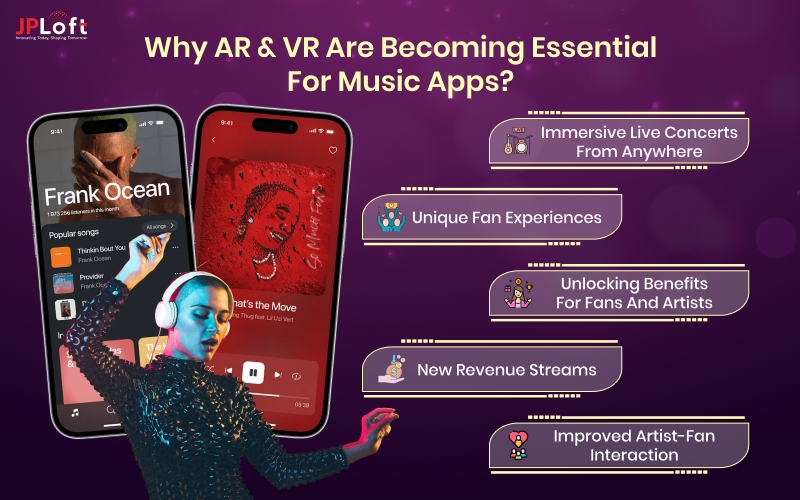
So, why should you care about this trend? Let’s explore the benefits and see how AR and VR are changing the music landscape.
1] Immersive Live Concerts from Anywhere
With AR/VR in music apps, fans no longer need to be physically present to experience live concerts.
Imagine attending a concert in a virtual reality environment where you can move around the stage, interact with the crowd, and feel like you’re there in person.
So, when you think of what is the future of virtual concerts and AR music apps? Think positive because, be it a global artist or an indie performer, VR brings concerts to fans worldwide.
2] Unique Fan Experiences
Using AR and VR in music apps, artists can offer exclusive fan experiences.
From virtual backstage passes to interactive music videos, fans get the chance to explore the artist's world in a way that feels personal and real.
This kind of engagement drives deeper connections between artists and their audiences.
Fans want to feel like they are part of the experience, and with Augmented Reality & Virtual Reality in your app, you can just deliver that.
3] Unlocking Benefits for Fans and Artists
People who are really interested in evolving trends of music apps often look for what are the benefits of using AR/VR in music apps for fans and artists.
For fans, AR and VR offer a more dynamic and personalized music experience.
For artists, these technologies open up new channels for revenue, such as virtual ticket sales and merchandise.
Virtual events are more cost-effective for artists while providing fans with exclusive access to content that can’t be found elsewhere.
The potential for global reach is unprecedented.
4] New Revenue Streams
With AR/VR, music apps are unlocking additional revenue sources.
Virtual concerts, meet-and-greets, and digital merchandise are all new opportunities for artists to generate income.
Fans can purchase limited-edition virtual tickets or buy concert experiences from the comfort of their homes.
These new channels diversify revenue and make music consumption more interactive.
5] Improved Artist-Fan Interaction
One of the huge benefits of AR/VR in music apps is that it offers ways for artist to connect with their fans.
Artists can hold virtual live sessions, where they can perform, answer questions, and interact with fans in real-time.
This creates a more intimate and meaningful fan experience, leading to greater loyalty and engagement.
With this out of the way, get insights about the use cases of AR and VR in music apps.
Top 8 Use Cases of AR & VR in Music Apps
Ever wondered how the use of AR & VR in music apps is totally changing the way we create, experience, and even feel music?
Spoiler alert: It's next-level exciting-- for both fans and artists.
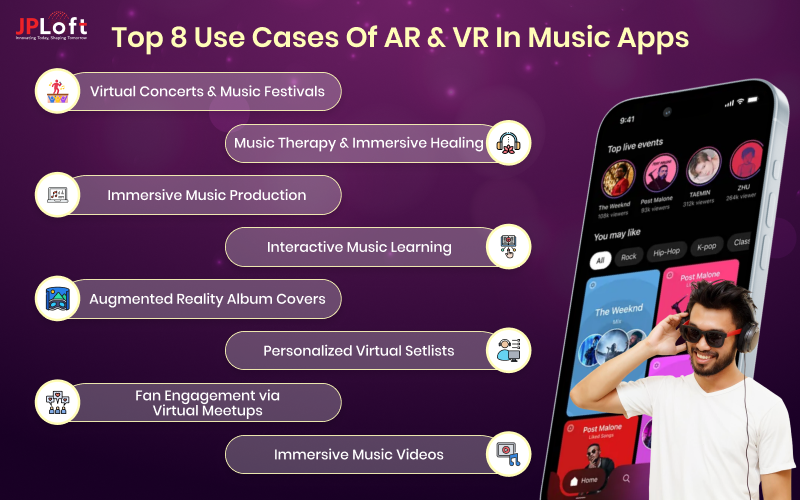
Let’s jump into some of the coolest ways AR and VR are making serious waves in the music world!
1. Virtual Concerts & Music Festivals (Your All-Access Pass, Anytime)
Picture this-- you’re front row at your favorite artist’s concert...but you’re chilling on your couch.
Thanks to VR-powered virtual concerts, that's not just possible-- it’s becoming the norm.
Artists like Travis Scott have already proven how powerful these immersive experiences can be. Virtual concerts are letting musicians reach millions without worrying about stadium sizes or ticket sales.
One of the biggest advantages of Augmented Reality and Virtual Reality in the music industry is exactly this: breaking down physical barriers so fans everywhere can experience unforgettable shows without limits.
(P.S. If you’re tracking hot trends in music apps, this is one you can’t ignore.)
2. Immersive Music Production (Produce Beats You Can Literally Touch)
Creating music inside a VR studio? Yep, that’s real life now.
AR VR app development is enabling artists to step into 3D digital audio workstations (DAWs), where they can physically move beats and samples around them.
For artists, the use of AR & VR in music apps opens up entirely new creative dimensions. You’re not stuck behind a screen-- you’re on the track.
This shift is a major game-changer when we talk about the benefits of using AR/VR in music apps for fans and artists, allowing musicians to innovate faster, collaborate remotely, and break free from traditional studio setups.
3. Augmented Reality Album Covers & Visualizations (Not Just Pretty Pictures)
Album covers used to just sit on your screen. Now? They move.
Scan an AR-powered album cover, and you might unlock hidden tracks, animations, or even personalized messages from the artist.
This kind of magic highlights the growing advantages of Augmented Reality and Virtual Reality in the music industry, giving fans richer, deeper connections to the music they love.
It's not just about boosting engagement; it’s about creating experiences people share-- and that’s marketing gold.
(Plus, if you're brainstorming must-have music app features, adding AR visualizations should be top of the list.)
4. Fan Engagement via Virtual Meetups & AR Filters (Way Beyond Likes)
Let's be real-- comment sections and DMs can only get you so far.
But meeting your favorite artist in a VR lounge? Or using exclusive AR filters that feature in their latest video? Now that's a real connection.
The use of AR & VR in music apps gives fans new, personal ways to engage with the artists they adore. And for musicians, it’s a golden ticket to building stronger communities.
5. Music Therapy & Immersive Healing (Music That Moves You...Literally)
Music has always had healing powers, but now, VR is taking it even deeper.
Imagine sitting in a serene virtual forest, guided by soothing music designed to lower stress or ease anxiety.
One of the most beautiful benefits of using AR/VR in music apps for fans and artists is how it's expanding into wellness.
It’s not just about entertainment anymore-- it’s about creating emotional, life-changing experiences.
6. Interactive Music Learning (Level Up Without Boring Lessons)
Learning an instrument used to mean boring scales and stiff classes.
Now, thanks to VR and AR, it feels more like playing a video game. Think holographic instructors, real-time feedback, and jamming sessions with virtual bands.
This innovation is another huge reason behind the growing advantages of Augmented Reality and Virtual Reality in the music industry-- especially for education-focused apps.
Making learning addictive instead of intimidating? That’s a serious win for both users and developers.
7. Personalized Virtual Setlists (Your Dream Show, Your Way)
Imagine attending a concert where the artist’s setlist adjusts based on your favorite songs.
Thanks to the smart use of VR and AI in music apps, this is actually possible now.
By combining immersive environments with real-time fan data, artists can tailor performances to different audiences-- even inside the same virtual tour.
It’s one more way music apps with AR and VR features are turning passive listeners into active participants. (And honestly? Fans are loving every second.)
8. Immersive Music Videos (Step Into the Story)
Remember when watching music videos meant sitting back and hitting play?
Well, not anymore. Now, AR and VR music technology let fans enter the story.
You could be walking through a neon city in a synthwave track...or exploring ancient ruins during a cinematic ballad.
Immersive videos aren't just next-gen entertainment-- they're helping artists create unforgettable brand experiences.
(And if you're eyeing the future of augmented reality music apps, interactive storytelling is where things are heating up fast.)
Popular Music Apps Crushing It with AR & VR
If you’re wondering whether adding immersive tech to a music app is worth it, just look at the top music apps that have already made the move.
Today, AR in music apps and VR in music apps aren’t just fancy extras-- they're becoming the secret sauce behind massive growth stories.
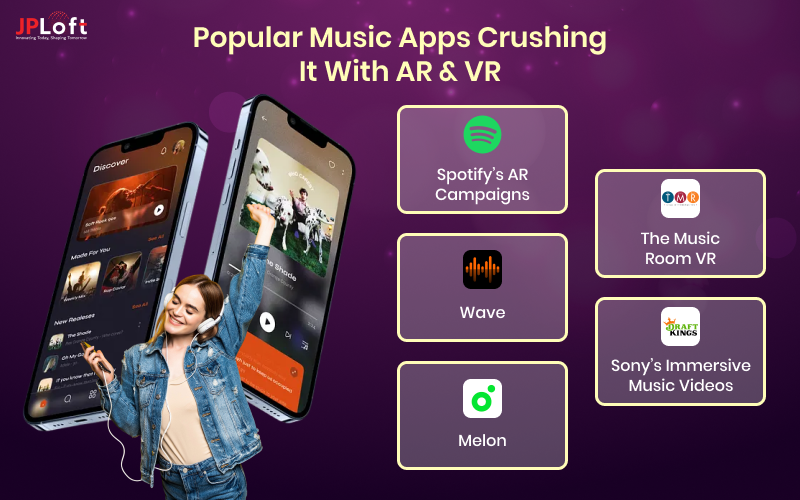
Here’s how some of the coolest immersive music apps are using this game-changing tech:
A] Spotify’s AR Campaigns
Spotify doesn’t just stream music-- they make it an experience.
With AR filters and immersive features, they let fans step into the world of their favorite artists.
Want to create a music app like Spotify? Adding AR and VR features can elevate fan engagement, making music drops feel unforgettable.
Just look at how apps like Spotify are leading the way by merging seamless streaming with innovative technology.
B] Wave: Virtual Reality Concert Magic
Wave is one of the pioneers in virtual reality music apps.
Instead of watching a show, you become part of it-- dancing, interacting, and even shaping the visuals around the artist in real time.
It's a whole new concert experience driven by powerful AR and VR music technology.
C] Melon: AR Music Storytelling
Melon is using AR in music apps to turn songs into interactive experiences.
Fans can follow storylines, unlock secret performances, and explore music worlds through their phones.
It’s storytelling, gamification, and fandom all rolled into one.
D] The Music Room VR
Imagine a studio where you can create, remix, and jam in VR.
The Music Room is leading the charge for VR in music apps, offering realistic instrument simulations and immersive creation spaces.
Perfect for artists looking for more tactile and intuitive music-making tools.
E] Sony’s Immersive Music Videos
Sony Music has been experimenting with music apps with AR and VR features, giving fans fully immersive music video experiences.
It's not just about watching a video anymore– it's about living inside it.
As you can see, AR and VR in the music industry aren’t a “maybe someday” thing.
It’s already happening-- and winning big.
Seeing these music apps adopting Augmented Reality & Virtual reality, it is safe to say that if you are considering starting an online music business, then now is the time to get started.
Key Challenges in Augmented Reality & Virtual Reality in Music Apps
As much as it is safe to say that AR and VR are changing user experience in every possible way, remember that building immersive apps isn’t without challenges.
From app security to user adoption issues, one should navigate several challenges in music app development that come while integrating these technologies.
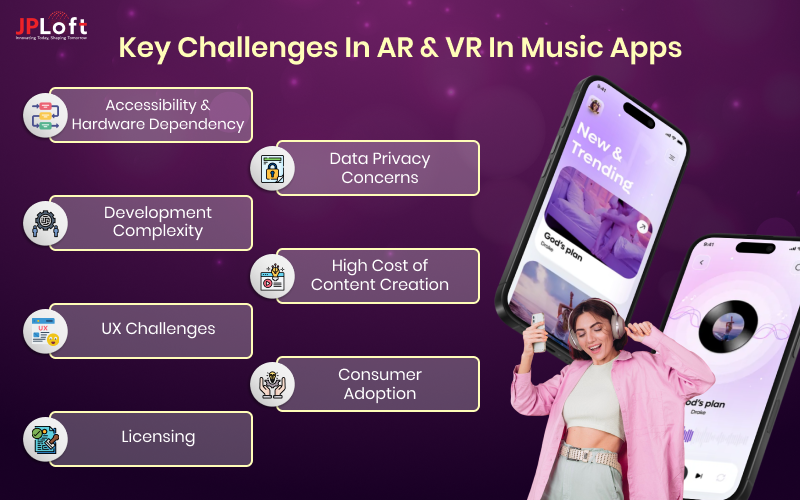
We are here to tell you what they are:
1. Accessibility & Hardware Dependency
One of the biggest hurdles with AR and VR music technology is the heavy reliance on high-end hardware.
While these immersive experiences can be amazing, not every user has access to VR headsets or AR-compatible devices.
This limits the reach of your music app and might affect engagement, especially if you're targeting users with varying levels of tech access.
2. Development Complexity & Resource Demands
Building AR/VR music experiences isn't a walk in the park.
It requires a team of skilled developers, 3D artists, and sound engineers to bring everything to life.
The development complexity and resource demands can make the process time-consuming and also increase the overall cost to create a music app, so you’ll need to plan your budget and timeline carefully.
3. UX Challenges in Spatial Environments
When it comes to AR and VR in music apps, designing for immersive environments can be tricky.
Users need intuitive, easy-to-navigate interfaces that feel natural in 3D spaces.
If the user experience isn’t seamless, it could result in frustration and disengagement, which is the last thing you want.
4. Licensing & Streaming Rights in Immersive Experiences
Adding AR and VR features to music apps creates new questions around licensing and streaming rights.
How do you handle artists' content in virtual environments or interactive experiences?
Navigating the legalities of immersive music experiences can be complex and time-consuming.
5. Data Privacy Concerns
With immersive technologies, you’re gathering more personal data than ever before.
From tracking user behavior in virtual environments to processing biometric data for personalized experiences, you’ll need to prioritize data privacy and compliance with laws like GDPR.
6. High Cost of Content Creation
To keep users engaged, you'll need constantly evolving content.
Creating high-quality, interactive music experiences can become costly, especially if you're using advanced technologies like 3D modeling, motion capture, and spatial audio.
It’s important to weigh the long-term investment against potential returns.
7. Consumer Adoption & Education
Despite the growing popularity of AR and VR, the average consumer may still be unfamiliar with these technologies.
Getting users on board means educating them about the benefits of immersive music apps and making the tech feel approachable and accessible.
The Future of AR & VR in the Music Industry
Say goodbye to your boring playlists and get ready for full blow virtual concert right in your living room.
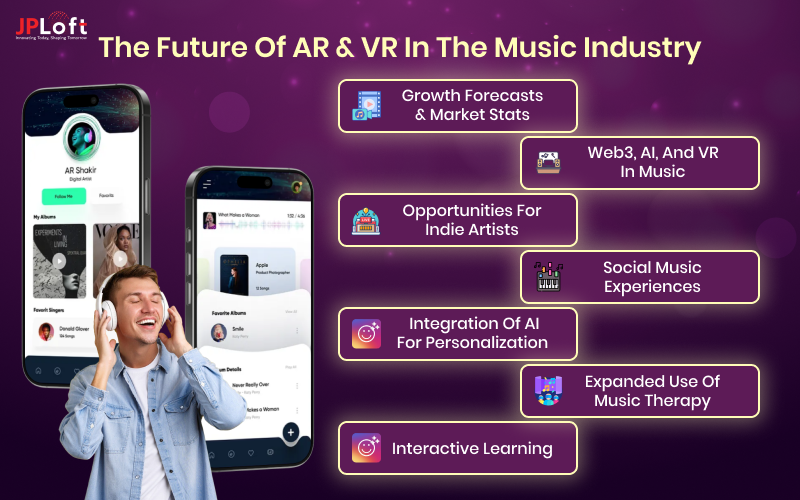
With Virtual Reality & Augmented Reality reshaping music apps, it’s time to take a peek at what’s next:
► Growth Forecasts & Market Stats
The future of AR and VR in music apps looks bright, with rapid growth predicted in the next few years.
With increasing investment in immersive technologies, analysts expect the global AR/VR market for music to reach significant milestones.
If you're thinking about building in this space, now's the time to jump on board.
► Web3, AI, and VR in Music
As Web3, AI, and VR intersect in music apps, expect a wave of new possibilities.
Imagine virtual concerts powered by AI, where the performance adapts in real-time based on audience interaction.
Web3 could even enable artists to directly monetize their immersive music experiences through NFTs or token-based economies.
► Opportunities for Indie Artists & Labels
One of the most exciting trends is the potential for indie artists and smaller labels to break through using immersive technologies.
AR and VR lower the barriers to entry by allowing musicians to create engaging, personalized experiences without needing massive production budgets.
This opens up new opportunities for emerging artists to connect with fans in ways they couldn’t before.
► Social Music Experiences in Virtual Spaces
The future of music is social, and virtual spaces will make that even more immersive.
Fans can interact with each other while attending virtual concerts, creating shared, real-time experiences.
For artists, this means new ways to build communities and deepen fan engagement.
► Integration of AI for Personalization
AI will play a huge role in the future of immersive music apps.
From personalized concert recommendations to dynamically adjusting music tracks based on listener mood, AI in music apps will make each experience feel tailor-made.
It’s all about enhancing the user journey and ensuring that every moment feels relevant and unique.
► Expanded Use of Music Therapy & Wellness
As immersive technologies evolve, expect a surge in music apps designed for mental and emotional well-being.
With VR environments that promote relaxation or help manage stress, these apps will offer users an even deeper connection to the healing power of music.
It’s not just entertainment-- it’s well-being through immersive music experiences.
► Interactive Learning and Gamification
The future will also see AR/VR and gamification merge in music. No wonder it's one of the fastest-growing trends in music apps today.
Interactive, hands-on learning with virtual instruments or holographic tutors will revolutionize how users learn to play music.
For developers, this means creating music apps that turn the learning process into a fun, engaging game, drawing in a wider audience.
How JPLoft Can Help You Develop an Integrating AR/VR in Your Music App?
If you are considering new evolving technologies such as VR & AR integration in your music app creation, now is the time to be serious about it.
To do so, you need an expert music app development company like JPLoft by your side. We specialize in bringing cutting-edge AR and VR experiences to life.
Be it aiming to create a virtual concert, interactive music lessons, or fully immersive soundscapes, our team combines deep technical expertise with creative innovation.
We work closely with you to design, develop, and seamlessly integrate AR/VR features that captivate users and keep them coming back for more.
Ready to move mountains, we are right here to help.
Conclusion
The fusion of AR and VR in music apps is revolutionizing how we experience sound, creativity, and connection.
From immersive live concerts to interactive learning, these technologies are pushing the boundaries of traditional music engagement.
As Gen Z and millennials demand more sensory-rich digital experiences, AR/VR in music industry solutions are becoming must-haves, not just nice-to-haves.
In this blog, we break down the benefits, trending use cases, top AR/VR music apps, and the opportunities they unlock for music startups and investors in 2025.
Whether you’re planning to create a futuristic music app or invest in one, this guide is your launchpad.
FAQs
AR enhances live shows with 3D visuals, overlays lyrics in real time, and enables interactive music learning or creation by projecting digital elements into the real world.
Yes, apps like Tribe XR, Wave, and SoundStage let users DJ, perform, or create music in immersive VR environments with virtual instruments and 3D interfaces.
Virtual reality in music offers immersive concert experiences, virtual studios, fan interactions, and 360° environments where users can explore or create music.
Yes, most VR systems allow background music playback or include music-based apps, letting users listen to or interact with music while immersed in virtual experiences
VR music is an audio experience in a 3D virtual environment, often combined with visuals, interactivity, or performance elements to create immersive musical experiences.





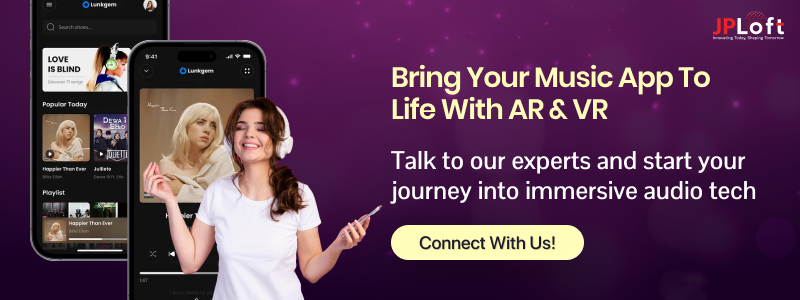
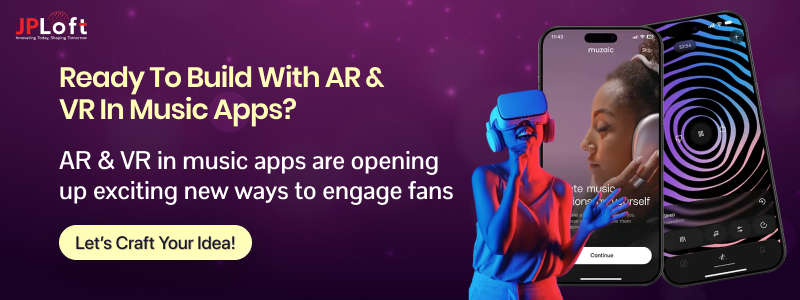

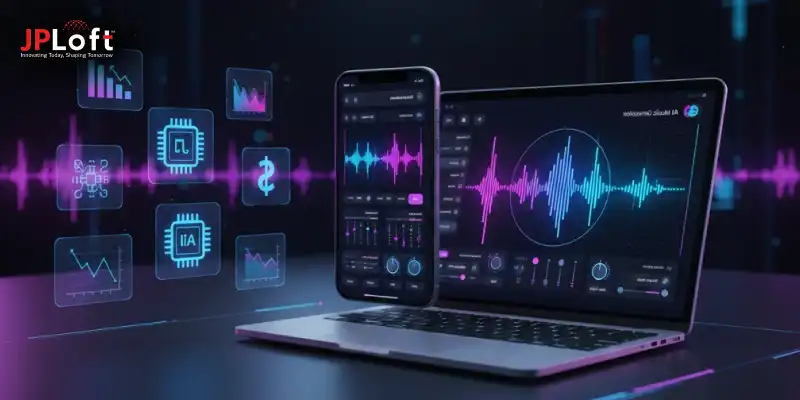
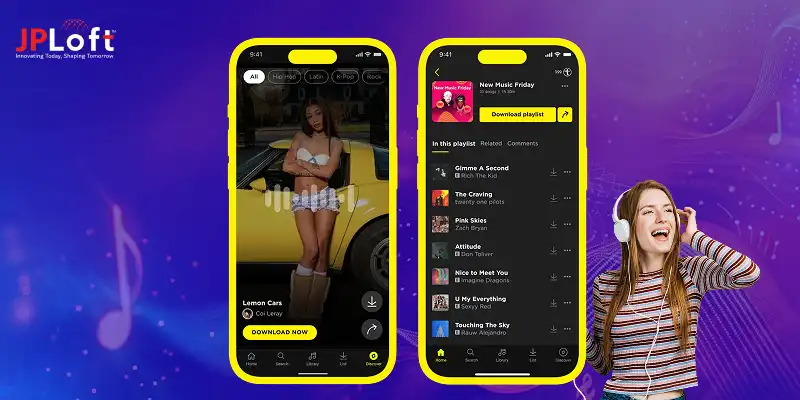
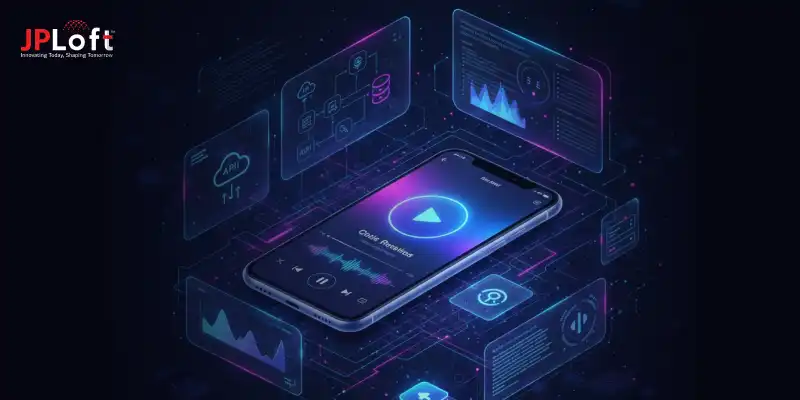


Share this blog